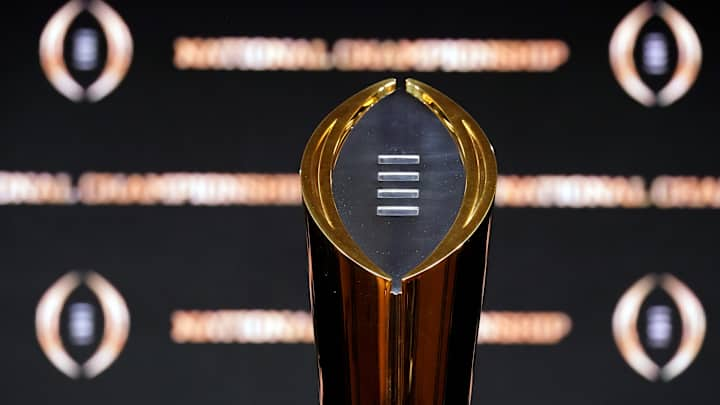Power 5 Conferences Aptly Named

A college football season that began in chaos and was characterized by an almost across-the-board lack of leadership concluded its regular season business in the same fashion.
And then some.
The CFP playoff committee basically got the Top 4 teams right, although you can debate for hours the Texas A&M-Ohio State decision.
What failed—and this time miserably—was the second tier of the system, which because of ESPN's desire for programming during the next two weeks has allowed 20 bowls to be played which should have been called off for a variety of reasons because of COVID-19 issues and restrictions.
The results of this are both shocking and should be embarrassing for the majority of college football.
Let's start with the most outrageous bowl news that I've seen in the 38 years I've been covering major college football.
In this COVID-19 bowl diminished season, six teams from the Southeastern Conference with a combined record of 19-40 are competing in bowl games, while Army at 9-2 was temporarily shut out before landing a spot in the Liberty Bowl against West Virginia. been shut out.
To make things worse, the Armed Forces Bowl, which will be played in Fort Worth, Texas on New Year's Eve afternoon and televised (of course) by ESPN will match up American Athletic Conference runner up Tulsa against 3-7 Mississippi State in the ARMED FORCES BOWL.
Two other SEC teams—3-7 Arkansas will face TCU in the Texas Bowl and 2-8 South Carolina will play UAB (Alabama-Birmingham) in the Gasparilla Bow—also are in bowl games.
On January 2, in one of the more attractive Florida bowls, 4-5 Mississippi will take on Indiana in the Outback Bowl and 4-6 Kentucky will face NC State in the Gator Bowl.
There are many villains in this story, the prime ones being the empty-suit leadership which comes from NCAA President Mark Emmert, whose group decided in the idea of fairness in this pandemic wracked seasons that the restrictions on a team winning half of its games would be lifted. Or the CFB powers that be which suspended the minimum win bowl qualification rule.
The prime beneficiary of this largesse was the SEC, unquestionably the leader of the Power 5 conferences in prestige and clout.
The fact that the SEC will send 11 of its 14 teams to bowl games this season, with only Vanderbilt (0-9) and LSU (5-5) and Tennessee (dropped out of Liberty Bowl because of Covid-19 issues).
SEC commissioner Greg Sankey did his job by setting up a system which had bowl slots for his teams, but one must wonder, when it came to the issue of whether the teams actually wanted to play in a bowl game (several members of the ACC and Pac-12 rejected any possible bowl bids), whether they were given the option of playing.
The NCAA, which is on the verge of college free agency in football and basketball as well as several other issues, exasperated this issue with its "let's reward the players for trying'' edict by not needing a winning season to play in a bowl game.
In order to understand where college football is right now, it is necessary to look back at a past which, perhaps to the surprise of some millennials, dates back past the year 2000.
For most of its modern history, college football post-season play was a Big Four Bowl system—Orange Bowl in Miami, Sugar Bowl in New Orleans, Cotton Bowl in Dallas and Rose Bowl in Pasadena.
CFB was then ruled by the Power 6 Conferences-Southeastern, Atlantic Coast, Big 8, Big 10, Southwest Conference and Pac-8 conference.
Each of the bowls had conference tie-ins.
The Rose Bowl was a closed bowl—Big Ten vs. Pac-8, then Pac-10 and now Pac-12.
The Sugar Bowl's anchor team was the SEC champ, the Orange Bowl was tied in with the Big 8 champ and then later the ACC champ, and the Cotton Bowl had the SWC champ as its anchor team.
The problem—if you want to call it that—was that the system was not set up to create a No. 1 vs. No. 2 match up.
Oh, it could happen, but rarely.
The Rose Bowl, for example, in the pre-BCS and CFB playoff days, had only two No. 1-2 match ups in its modern history—the 1963 game between Wisconsin and USC and the the 1969 game between USC and Ohio State.
Unless it happened by luck, there was no system set up to match up the No. 1 vs. No. 2 teams from different conferences outside of the Rose Bowl.
The Orange Bowl did have an historic No. 1 vs. No. 2 game in 1971 when Nebraska tangled with Alabama, which normally would have been committed to the Sugar Bowl as SEC champion.
But at the time it was an understanding rather than a contract and Alabama, coached by the legendary Paul Bear Bryant, dictated where the Tide went for post season, which is why he jumped on the opportunity to take on No. 1 Nebraska in Miami.
Unfortunately for Alabama, it turned into a 38-6 Nebraska romp.
But the issue of No. 1 was basically left to a poll system of writers and coaches, which caused long off season debates for many years, which wasn't regarded as a bad thing by the CFB rulers.
Missing from this equation were the independents such as Notre Dame and much of the Eastern bloc of the country, which had no major football conference.
That changed in the early 1990's with the creation of the Big East football conference, which was sprung as an idea from the highly successful Big East basketball conference, which was dominating the sport, comprised of a core group of seven Catholic schools.
Then Big East commissioner Mike Tranghese tried to expand the brand with Big East football by grouping together a group of his football schools such as Rutgers, West Virginia, Pittsburgh, Boston College, UConn, Syracuse with Miami and Virginia Tech. He also wanted to include Penn State as the lynch pin of that arrangement.
The failure to do that changed the landscape of college football.
With Penn State as part of the foundation, there would have been no ACC poaching of Big East schools, there would have been a solid Eastern group of schools which would have made the Big East a Power 6 conference after the SWC folded and merged into the Big 12.
But a Civil War between the Big East Catholic non-major FB playing schools and the other schools competing at the FBS level in football, as well as Penn State's move to the Big Ten led to the eventual demise of Big East football.
While that was happening, the bowl system was evolving. The Cotton Bowl lost some clout and the Orange Bowl was having financial difficulties, which led to the Fiesta Bowl, which moved into the Top 4 bowl tier.
The call for some sort of on the field settlement of Who's No. 1 created the BCS and eventually the CFP system, which has now evolved into a New Year's Six (the Peach Bowl in Atlanta) rotation which includes a Final Four semifinal round each year for two bowls as well as 8 other slots for champions and runners up.
The Power 5 conferences—Big Ten, ACC, SEC, Big 12 and Pac-12–dominated this landscape, which created cries of protests from the other (Group of 5) conferences playing FBS football.
When the CFP system of four teams was created five years ago, the Power 5 conferences conceded one guaranteed spot for a Group of 5 team in the New Year's 6 bowl game slots.
It DID NOT guarantee a Final Four slot for any Power 5 team, although any team with a Top 4 ranking (chosen by a selection committee) was eligible.
This year's winner was unbeaten Cincinnati, which was the unbeaten champ of the American Athletic Conference. The Bearcats will face Georgia in the Peach Bowl on January 2nd, but finished a distant 8th behind once beaten Notre Dame, once beaten Texas A&M, twice beaten Oklahoma and 3-time loser Florida in the final CFP rankings.
The other Group of 5 team which deserved consideration was unbeaten Coastal Carolina, which finished its season with an 11-0 record, but were dumped on at every level.
Start with their final CFP ranking of No. 12, which was behind a 3 loss Iowa State team, which lost to Oklahoma in the Big 12 championship game and was rewarded with a New Year's Six berth in the Fiesta Bowl against Pac-12 champion Oregon.
Here's the problem.
One of Iowa State's three losses was to Louisiana-Lafayette, who beat them in Ames by a score of 31-14.
Louisiana's only LOSS this season was to Coastal Carolina.
A rematch was set up in the SunBelt Conference championship game was called off because of COVID-19 issues.
But then the Sunbelt decided to split the championship between the two teams.
That's flat out wrong. Coastal had the better record and won the head-to-head match up.
It gets worse.
Coastal finished behind Cincinnati in the CFP rankings, which is debatable if you look at a comparison of records.
But then Iowa State, which lost at home by two touchdowns to a team (Louisiana) beat, and which lost 3 games, was given a New Year's Bowl Six slot.
The evidence is circumstantial, but obvious. The CFB powers were willing to give the Group of Five ONE spot, but NOT two.
All of this is part of the landscape of a college football season that should be soon forgotten, but unfortunately will always be remembered--for mostly negative events and actions.
